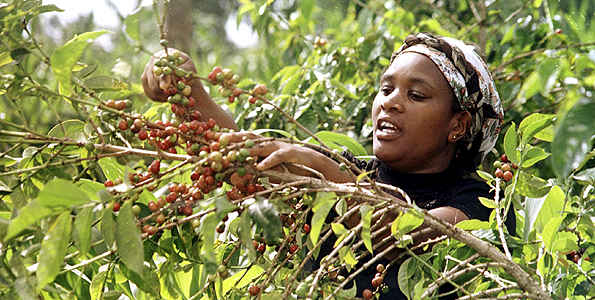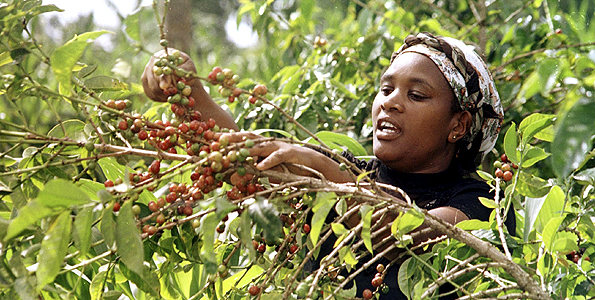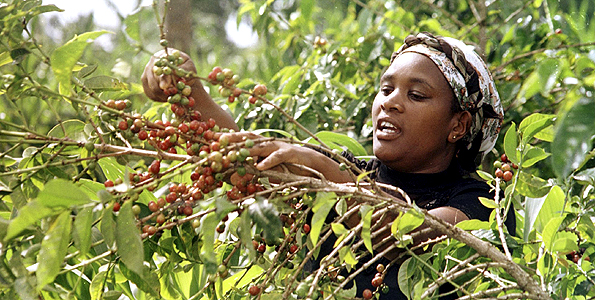Dry water washing roasted coffee beans raw beans Ethiopian Sidamo sun treatment Lion King
The difference between dry and water-washed coffee
Differences in appearance:
The water content of water-washed coffee is 12%, while that of dry coffee beans is 11%, 12%. Outwardly, the former looks darker green. Generally speaking, the raw beans with higher water content are mostly green or cyan, while those with less water content are brown or close to white. Raw beans because the silver skin of the washing refining method (the skin attached to the surface of the raw beans) has been removed, the surface of the beans shows a special luster, while the drying refining method mostly retains the silver skin after shelling.
Defective beans are mixed:
Brazilian coffee beans are refined by non-washing method. Except for some high-quality products, most of the beans are not very good because they are mixed with many unripe or overripe beans. Among these defective beans, unripe beans and fermented beans upset the baker the most. So it is particularly important to hand-select the process before baking.
Unwashed coffee in Yemen and Ethiopia is also the same as in Brazil, with quite a lot of impurities and defective beans, so cleaning takes longer than baking.
The water-washed raw beans need to be washed many times before they become products, the stone and wood layers are not easy to mix, there are few defective beans, there are fewer beans to pick out, but sometimes mixed with fermented coffee beans. On the contrary, this makes it more difficult to find defective beans by washing refining than by non-washing refining.
The baking method is different:
The high-quality coffee produced in Brazil, which uses natural drying to refine coffee beans, is rarely uneven in size and is quite suitable for baking, because the natural drying method removes moisture from the center of coffee beans, so that beans with mild sour taste and less astringent taste can be baked. The most difficult part of baking is the control of sour and astringent taste. Generally speaking, the water washing refining method has a strong sour and astringent taste because the drying period is short.
There are many ways to ease the sour and astringent taste, or to leave the beans at rest for a while, or to bake new beans longer than baked beans refined by natural drying.
Sometimes it seems that water-washed coffee is more difficult to bake, but when baking natural drying mocha and Manning, you will find that they also have other difficulties. Beans refined by natural drying will have uneven size and uneven drying, so the difficulty is to avoid overbaking, which is related to the actual baking experience.
Ethiopian Sidamo Lion King Natural
Country: Ethiopia
Grade: G1
Production area: Guji
Planting altitude: 1800-2000m
Soil type: volcanic laterite
Annual rainfall: 1100-1200 cm
Treatment: insolation
Variety: native species (Heirloom)
Disposal site: Sirsa Cooperative
Raw bean specification: 17-18 mesh
Flavor: Jasmine, honey, citrus, ripe berries

Important Notice :
前街咖啡 FrontStreet Coffee has moved to new addredd:
FrontStreet Coffee Address: 315,Donghua East Road,GuangZhou
Tel:020 38364473
- Prev

Coffee from fruit to raw bean dry washing semi-washing refined Colombian coffee beans
Coffee changes from fruit to raw bean there is a pair of oval seeds in the middle of the fruit, which are covered with outer skin, inner pulp and pulp. Ripe fruit spoils in a short time without treatment. Refining is to remove the skin and pulp of the coffee fruit, and then take out the seeds. Generally speaking, about 1 kg of raw coffee beans can be obtained from 5 kg of coffee fruit. The refining methods include drying and washing.
- Next

Ethiopian Sidamo Sun treatment Lion King Yissoya Sidama Black Coffee Coffee net
The coffee flavor of Sidamo is very diverse, and the different soil types, microclimate and countless native coffee species make the coffee produced in each town have obvious differences and characteristics. In 2010-12, it won three consecutive high marks from coffee review 92 to 94, which shows the extraordinary value of raw beans in this area! Domestic horizontal
Related
- Does Rose Summer choose Blue, Green or Red? Detailed explanation of Rose Summer Coffee plots and Classification in Panamanian Jade Manor
- What is the difference between the origin, producing area, processing plant, cooperative and manor of coffee beans?
- How fine does the espresso powder fit? how to grind the espresso?
- Sca coffee roasting degree color card coffee roasting degree 8 roasting color values what do you mean?
- The practice of lattes: how to make lattes at home
- Introduction to Indonesian Fine Coffee beans-- Java Coffee producing area of Indonesian Arabica Coffee
- How much will the flavor of light and medium roasted rose summer be expressed? What baking level is rose summer suitable for?
- Introduction to the characteristics of washing, sun-drying or wet-planing coffee commonly used in Mantenin, Indonesia
- Price characteristics of Arabica Coffee Bean Starbucks introduction to Manning Coffee Bean Taste producing area Variety Manor
- What is the authentic Yega flavor? What are the flavor characteristics of the really excellent Yejasuffi coffee beans?

